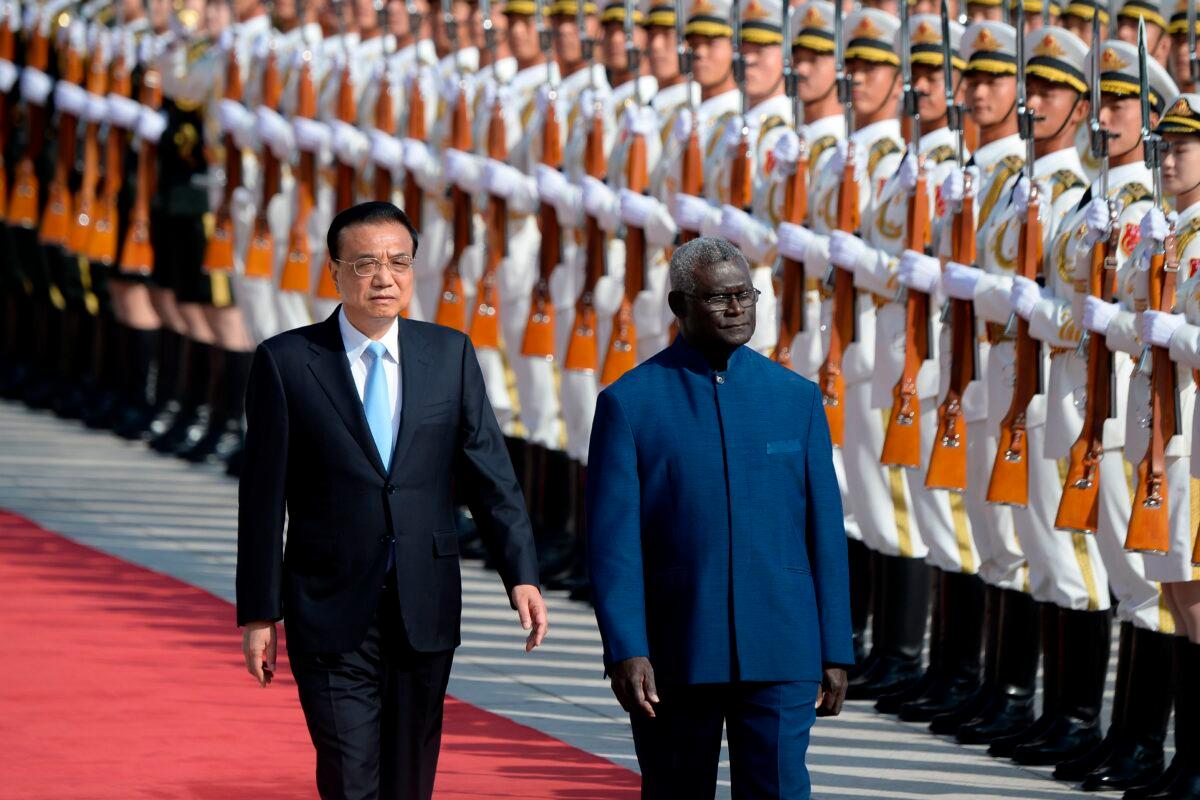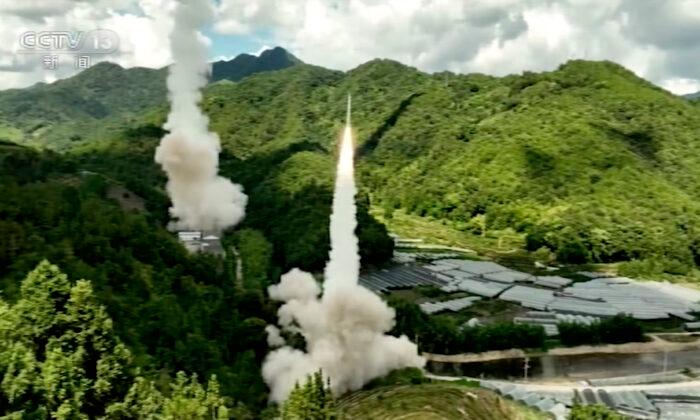Called its “touchstone,” the modern Australia-United States alliance emerged from the shared sacrifices that began most prominently with the Battle of the Coral Sea (May 4-8, 1942). This area encompasses the northeastern shores of Australia, western Papua New Guinea (PNG), and the Solomon Islands chain.
Japan’s principal goal was to isolate Australia and New Zealand, first by taking over the surrounding islands of the South Pacific and then to possibly invade Australia, secure Japan’s conquest and resource exploitation of Southeast Asia, and prevent the United States from mounting a counteroffensive from the South Pacific.
By the end of December 1941, Japan’s navy was advocating for an invasion of northern Australia, but the army did not have the resources. On Feb. 19, 1942, four Japanese navy aircraft carriers, plus Indonesian-based Japanese bomber groups, would launch 242 aircraft to bomb the important Australian port city of Darwin, beginning a campaign that would see Japan bomb Australia about 100 times through late 1943.
Japan’s navy then devised a more realistic strategy that included invading the Solomon Islands, creating a base on Tulagi, and then invading and capturing Port Moresby in PNG, allowing Japanese bombers to carry heavier bombs payloads against Australian targets.
Exploiting the breaking of Japan’s communications codes, the United States deduced Japan’s plans, sent two carrier groups to the region, mounted a surprise bomber strike from Australia against Tulagi on May 3, followed on May 7 and 8 with the world’s first long-distance clash of aircraft carriers: Japan’s Shokaku, Zuikaku, and Shoho against the U.S. Navy’s Yorktown and Lexington.
U.S. Navy losses, the large carrier Lexington, serious damage to the Yorktown, and the loss of a tanker and destroyer, appeared to exceed Japan’s loss of the light carrier Shoho, while Shokaku and Zuikaku suffered damage.

But the battle was a strategic victory for the allies in that Japan withdrew its Port Moresby invasion fleet, preventing a future Japanese invasion of Australia. At the same time, Japan’s losses contributed to its larger defeat in the Battle of Midway (June 4–7, 1942).
An honest evaluation of Japan’s brilliant 1941 to 1942 campaign that conquered Southeast Asia and almost conquered the South Pacific has only been politically possible by China’s People’s Liberation Army (PLA) since the early 2000s.
This also coincides with the Chinese Communist Party’s (CCP) beginning to implement political and military plans for obtaining global political-military hegemony, which requires the CCP to subordinate the democracies of Australia and New Zealand, and to build air-naval-nuclear missile bases in the South Pacific.
The CCP wants to secure the mineral and agricultural riches of Australia and New Zealand, sever Australia from its U.S. alliance, and secure the CCP’s economic-political-military projection to South America and into the Indian Ocean.
Such strategic gains would also serve to isolate the U.S. bases in Guam, threaten the important U.S. missile testing base in Kwajalein, threaten U.S. bases in Hawaii, and ultimately help secure Antarctica as a base to dominate low Earth orbit—crucial for winning wars globally.
China’s cunning improvement of Japan’s strategy started with two decades of indirect political-economic assault on Australia, New Zealand, and the South Pacific to secure requisite economic and political leverage that would yield military bases to implement future isolation campaigns or even physical invasion.
“Who is weaker on China” is now an issue in Australia’s current election because elites on both sides of politics have allowed for a dangerous dependency on commerce with China, which the CCP has repeatedly exploited with political interventions and direct threats.
Chinese coercion led to the September 2021 decision to form Australia-United Kingdom-United States (AUKUS) defense arrangement to help Australia acquire more powerful defense systems, including nuclear-powered submarines. China has reacted to AUKUS with fury and direct military intimidation of Australia.
In the same week, in late February, the PLA Navy (PLAN) sent a Type 071 landing platform dock (LPD) amphibious assault ship to Tonga and sailed another through Australia’s northern Torres Strait. And on May 3, a large PLAN electronic intelligence gathering ship sailed off Australia’s east coast for at least 10 days.
Now there is a greater urgency to prepare for the next Battle of the Coral Sea as China is on the cusp of establishing major bases in the Solomon Islands.
Following anti-China riots that threatened the pro-CCP government of Prime Minister Manasseh Sogavare in December 2021, Beijing deployed a slush fund to pay members of parliament $30,000 each to vote to keep Sogavare in power.

By early 2022, it was revealed that Sogavare had been negotiating to allow China to build “civilian” deep ports and airports. And in April, his government signed a military cooperation agreement that reportedly will enable China to deploy troops to protect Chinese interests.
Should the PLA establish bases in the Solomons, similar to the PLA bases in the South China Sea, it will be able to accommodate aircraft carrier battle groups, long-range bombers, and intermediate-range nuclear missiles like the 2,485-mile range DF-26.
During an April 22 meeting, the Biden administration’s National Security Council (NSC) Indo-Pacific coordinator, Kurt Campbell, the highest NSC Asia-policy official, gave Sogavare a direct warning that a Chinese military base could lead to a U.S. invasion, with a formal public readout stating: “If steps are taken to establish a de facto permanent military presence, power-projection capabilities, or a military installation ... the United States would then have significant concerns and respond accordingly.”
In 2022, this is a credible threat, as the United States could quickly mobilize four to five aircraft carrier battle groups and possibly 10 or so LPD and landing helicopter dock (LHD) amphibious assault ships, plus 10 nuclear attack submarines.
However, by 2030, the PLAN could potentially mobilize four or five aircraft carrier battle groups and up to 15 LPDs and LHDs, plus about 10 nuclear attack submarines, with the aircraft to deploy 1,056-mile range DF-21D and DF-26 anti-ship ballistic missiles.
If PLAN fleets broke through, this would be enough to deploy three mechanized brigades to conduct a punitive raid against Darwin or to occupy the North and South islands of New Zealand.
Due to woke politics, New Zealand has no combat air force, and due to its Soviet-manipulated 1980s anti-nuclear laws, it would be “illegal” for the United States to attack a PLA invasion force on New Zealand territory with submarine-launched tactical nuclear weapons—perhaps all it could mobilize in time.
But here is the crux: for the next Battle of the Coral Sea, both Australia and New Zealand will require long-range strike aircraft armed with long-range anti-ship missiles, as they ultimately will require tactical nuclear weapon-armed intermediate-range missiles to deter Chinese coercion or invasion to preserve their freedom.
Despite deep anti-nuclear sentiment with both, they need to consider this capability as the Biden administration is confused; it has recently canceled a new tactical nuclear-armed sea-launched cruise missile (SLCM-N), which could allow concealed U.S. nuclear attack submarines to quickly provide a decisive deterrent.
As aircraft carriers proved their war-winning potential in the 1942 Battle of the Coral Sea, the next one will be dominated by long-range missiles launched from land bases, ships, submarines, and aircraft supported by aerial and space surveillance and control systems.





